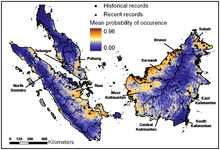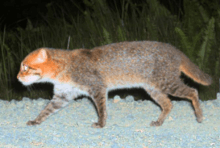Flat-headed cat
| Flat-headed cat[1] | |
|---|---|
| | |
| Scientific classification | |
| Kingdom: | Animalia |
| Phylum: | Chordata |
| Class: | Mammalia |
| Order: | Carnivora |
| Family: | Felidae |
| Genus: | Prionailurus |
| Species: | P. planiceps |
| Binomial name | |
| Prionailurus planiceps (Vigors & Horsfield, 1827) | |
 | |
| Range of flat-headed cat[3] | |
The flat-headed cat (Prionailurus planiceps) is a small wild cat patchily distributed in the Thai-Malay Peninsula, Borneo and Sumatra. Since 2008, it has been listed as Endangered on the IUCN Red List due to destruction of wetlands in its habitat. It is suspected that the effective population size could be fewer than 2,500 mature individuals, with no subpopulation having an effective population size larger than 250 adult individuals.[2]
Like some other small cats, it was originally placed in the genus Felis, but is now considered one of the five species in Prionailurus.[1][4]
Flat-headed cats are very rare in captivity, with fewer than ten individuals, all kept in Malaysian and Thai zoos as recorded by ISIS.[5]
Characteristics
The flat-headed cat is distinguished at once by the extreme depression of the skull, which extends along the nose to the extremity of the muzzle, the sides of which are laterally distended. The general habit of body is slender, and the extremities are delicate and lengthened. The head itself is more lengthened and cylindrical than in the domestic cat. The distance between the eyes and the ears is comparatively great. The cylindrical form and lateral contraction of the head is contrasted by an unusual length of the teeth. The canine teeth are nearly as long as in an individual of double its size.[6]
The thick fur is reddish-brown on top of the head, dark roan brown on the body, and mottled white on the underbelly. The face is lighter in color than the body, and the muzzle and chin are white. Two prominent buff whitish streaks run on either side of the nose between the eyes. The ears are rounded. The eyes are unusually far forward and close together, compared with other cats, giving the felid improved stereoscopic vision. The teeth are adapted for gripping onto slippery prey, and the jaws are relatively powerful. These features help the flat-headed cat to catch and retain aquatic prey, to which it is at least as well adapted as the fishing cat. Legs are fairly short. Claws are retractable, but the covering sheaths are so reduced in size that about two-thirds of the claws are left protruding.[7]
The anterior upper premolars are larger and sharper relative to other cats. The inter-digital webs on its paws help the cat gain better traction in muddy environments and water, and are even more pronounced on this cat than those on the paws of the fishing cat.[8]
It has a head-and-body length of 41 to 50 cm (16 to 20 in) and a short tail of 13 to 15 cm (5.1 to 5.9 in).[4] It weighs 1.5 to 2.5 kg (3.3 to 5.5 lb).[9]
Distribution and habitat

The distribution of flat-headed cats is restricted to lowland tropical rainforests in extreme southern Thailand, Peninsular Malaysia, Sabah, Sarawak, Brunei Darussalam, Kalimantan and Sumatra. They primarily occur in freshwater habitats near coastal and lowland areas. More than 70% of records were collected less than 3 kilometres (1.9 mi) away from water.[3]
Flat-headed cats occur in both primary and secondary forest.[10]
Flat-headed cats were recorded in the Pasoh Forest Reserve in Peninsular Malaysia in 2013.[11] As Pasoh contains no major rivers or lakes and is generally covered by hill dipterocarp forest, this detection provides new evidence of the species’ potential habitat range. Pasoh ranks as low probability of occurrence in a previously published species distribution model.[3] Pasoh's surrounding landscape is dominated by plantations that have been established since the 1970s. The detection, occurring < 1.5 km (0.93 mi) from oil palm plantations, suggests that the flat-headed cat is more tolerant of changes in its surrounding environment than previously assumed.[11]
Ecology and behavior
Flat-headed cats are presumably solitary, and probably maintain their home ranges by scent marking. In captivity, both females and males spray urine by walking forward in a crouching position, leaving a trail on the ground.[12] Anecdotal historical accounts report that flat-headed cats are nocturnal, but an adult captive female was crepuscular and most active between 8:00 and 11:30 and between 18:00 and 22:00 hours.[7]
The stomach contents of an adult shot on a Malaysian riverbank consisted only of fish. They have been observed to wash objects, raccoon-style. Live fish are readily taken, with full submergence of the head, and the fish were usually carried at least two meters away, suggesting a feeding strategy to avoid letting aquatic prey escape back into water. Captive specimens show much greater interest in potential prey in the water than on dry land, suggesting a strong preference for riverine hunting in their natural habitat.[13] Their morphological specialization suggest that their diet is mostly composed of fish, but they are reported to hunt for frogs, and are thought to catch crustaceans.[7] They also catch rats and chicken.[8]
Vocalizations of a flat-headed cat kitten resembled those of a domestic cat. The vocal repertoire of adults has not been analyzed completely, but they purr and give other short-ranged vocalizations.[14]
Their gestation period lasts about 56 days. Of three litters recorded in captivity one consisted of two kittens, the other two were singletons. Two captive individuals have lived for fourteen years.[7][8]
Threats
The flat-headed cat is primarily threatened by wetland and lowland forest destruction and degradation.[8] Causes of this destruction include human settlement, forest transformation to plantations, draining for agriculture, pollution, and excessive hunting, wood-cutting and fishing. In addition, clearance of coastal mangroves over the past decade has been rapid in tropical Asia. The depletion of fish stocks from over-fishing is prevalent in many Asian wetland environments and is likely to be a significant threat. Expansion of oil palm plantations is currently viewed as the most urgent threat.[2]
It is also threatened by trapping, snaring and poisoning.[7] Flat-headed cats have been captured in traps set out to protect domestic fowl.[8]
Although flat-headed cats are not known to be a specific target for poachers in Southeast Asia, side-catch poaching in small snares might pose an additional threat for the species. In fragmented landscapes motor vehicle collisions and direct competition with domestic cats could pose more serious threats.[11]
Conservation
The flat-headed cat is included on CITES Appendix I. It is fully protected by national legislation over its range, with hunting and trade prohibited in Indonesia, Malaysia, and Thailand.[2]
Taxonomic history
The flat-headed cat was initially placed in the genus Felis by Vigors and Horsfield, who first described the cat in 1827 from Sumatra.[6] In 1951, Ellerman and Morrison-Scott grouped Felis planiceps with Felis viverrina, the fishing cat, as being distributed in Lower Siam, the Malay States, Sumatra and Borneo, and recorded from Patani.[15] In 1961, it was subordinated to the genus Prionailurus by the German biologist Weigel who compared fur pattern of wild and domestic felids.[16] In 1997, researchers from the National Cancer Institute confirmed this taxonomic ranking following their phylogenetic studies.[17]
References
- 1 2 Wozencraft, W.C. (2005). "Order Carnivora". In Wilson, D.E.; Reeder, D.M. Mammal Species of the World: A Taxonomic and Geographic Reference (3rd ed.). Johns Hopkins University Press. p. 543. ISBN 978-0-8018-8221-0. OCLC 62265494.
- 1 2 3 4 Wilting, A.; Brodie, J.; Cheyne, S.; Hearn, A.; Lynam, A.; Mathai, J.; McCarthy, J.; Meijaard, E.; Mohamed, A.; Ross, J.; et al. (2015). "Prionailurus planiceps". IUCN Red List of Threatened Species. Version 2016-3. International Union for Conservation of Nature.
- 1 2 3 4 Wilting, A.; Cord, A.; Hearn, A. J.; Hesse, D.; Mohamed A., Traeholdt; C., Cheyne; S. M., Sunarto; S., Jayasilan; M., Ross; J., Shapiro; A. C., Sebastian; A., Dech; S., Breitenmoser; C., Sanderson; J., Duckworth; J. W.; Hofer, H. (2010). "Modelling the Species Distribution of Flat-Headed Cats (Prionailurus planiceps), an Endangered South-East Asian Small Felid". PLoS ONE. 5 (3): e9612. PMC 2840020
 . PMID 20305809. doi:10.1371/journal.pone.0009612.
. PMID 20305809. doi:10.1371/journal.pone.0009612. - 1 2 Nowak, R. (1999). Walker's Mammals of the World. 6th edition. The Johns Hopkins University Press. ISBN 0-8018-5789-9.
- ↑ International Species Information System (2011) Captive Prionailurus planiceps. Accessed 13 October 2011
- 1 2 Vigors, N. A., Horsfield, T. (1827). Description of two Species of the genus Felis, in the collection of the Zoological Society. The Zoological Journal Vol. III: 449–450.
- 1 2 3 4 5 Sunquist, M.; Sunquist, F. (2002). Wild Cats of the World. The University of Chicago Press. pp. 233–236. ISBN 0-226-77999-8.
- 1 2 3 4 5 Nowell, K., Jackson, P. (1996). "Flat-headed Cat. Prionailurus planiceps". Wild Cats: status survey and conservation action plan. Gland, Switzerland: IUCN/SSC Cat Specialist Group.
- ↑ Francis, C. (2001). A Photographic Guide to Mammals of South-east Asia including Thailand, Malaysia, Singapore, Myanmar, Laos, Cambodia, Vietnam, Java, Sumatra, Bali and Borneo. New Holland. ISBN 1859745075.
- ↑ Payne, J., Françis, C. M., Phillipps, K. (1998). A Field Guide to the Mammals of Borneo. Sabah Society. 3rd reprint. ISBN 967-99947-1-6.
- 1 2 3 Wadey, J.; Fletcher, C.; Campos-Arceiz (2014). "First Photographic Evidence of Flat-Headed Cats (Prionailurus planiceps) in Pasoh Forest Reserve, Peninsular Malaysia". Tropical Conservation Science. 7 (2): 174.
- ↑ Leyhausen, P. (1979). Cat behaviour. The predatory and social behaviour of domestic and wild cats. Garland STPM Press; New York ISBN 0-8240-7017-8.
- ↑ Muul, I.; Lim, B. L. (1970). "Ecological and morphological observations of Felis planiceps". Journal of Mammalogy. 51 (4): 806–808. JSTOR 1378310. doi:10.2307/1378310.
- ↑ Peters, G. (1981). "Das Schnurren der Katzen". Säugetierkundliche Mitteilungen (29): 30–37.
- ↑ Ellerman, J. R., Morrison-Scott, T. C. S. (1966). Checklist of Palaearctic and Indian mammals 1758 to 1946. Second edition. London: British Museum of Natural History.
- ↑ Weigel, I. (1961). "Das Fellmuster der wildlebenden Katzenarten und der Hauskatze in Vergleichender und Stammesgeschicher Hinsicht". Säugetierkundliche Mitteilungen (9): 1–120.
- ↑ Johnson, W. E.; O'Brien, S. J. (1997). "Phylogenetic reconstruction of the felidae using 16S rRNA and NADH-5 mitochondrial genes". Journal of Molecular Evolution. 44: S98–116. PMID 9071018. doi:10.1007/PL00000060.
External links
| Wikimedia Commons has media related to Prionailurus planiceps. |
| Wikispecies has information related to: Prionailurus planiceps |
